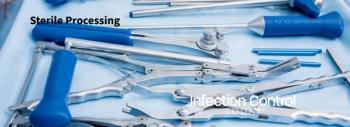
A Strategy to Ensure IFUs are Followed in the SPD
By Nancy Chobin, RN, AAS, ACSP, CSPM, CFER
Q: Our department was recently cited for not having manufacturer’s written instructions (IFUs) for all the devices we clean and sterilize. How do we ever comply with this? We have so many items to process.
A: Your concern is one I hear often. Long gone are the days of processing just basic instruments. In the past, maybe 10 percent of the devices were “special," thereby requiring some special cleaning or sterilization. Today, it is the reverse; approximately 80 percent of the devices we process require special cleaning and/or sterilization instructions.
The sophistication of today’s medical devices makes it critical that IFUs be obtained and available for all devices being reprocessed, regardless of how long a device has been in use. Many manufacturers regularly update their IFUs; therefore, to ensure the safety of the device, it is essential that SPD technicians have the most current information. he best approach is to obtain the IFU before a device is purchased so that it can be verified that the processing equipment and cycle parameters recommended by the device manufacturer are available at the facility.
If the device is new (meaning it has never been used in your facility before), it is important to ensure that the staff is in-serviced in the cleaning, disinfection, or sterilization of the device according to the IFU. Thereafter, the IFU should be required each time the device is purchased. When the device is received, the IFU should be reviewed and compared to the information on file. If the IFU has been updated, SPD personnel should be in-serviced in the changes and the new IFU dated and placed in the reference binders. If the IFU is the same, no action need be taken.
However, you first, you need to start with a very strong policy and procedure that states your department will not process any device or instrument without specific written IFUs. As a matter of fact, no reusable instrument or device should even be brought into your facility unless the IFUs have been obtained and reviewed by you. Why would any facility bring in a device only to find they do have the equipment or chemicals to clean, high level disinfect and/or sterilize the device? This happens every day and then the problem becomes one for SPD. What to do? While some of the surgeons may not be happy with this change, once they understand the patient safety and legal liability associated with improperly processed devices, they agree.
While the policy is being approved you can start to obtain IFUs from your vendors. If you are a larger facility, there is an online IFU site that you can subscribe to. However, you still need to review the IFU to make sure you can comply with it.
The cleaning information must be readily available to the staff for reference in the decontamination area. You can install a computer monitor in the area, so that staff members can access the IFUs. However, surveying agencies are asking for a back-up system in the event the online service goes down or if your computer system goes down. So, it is recommended to download and copy the cleaning instructions and place them in plastic page protectors and place in the decontamination area. Provide the date when they were downloaded.
The same goes for the prep and packaging/sterilization area; have the IFUs available on a computer or hard copy for easy staff access.
Some individuals think that the fact that the IFUs are now in the department means their responsibility is over. Not true. You need to monitor that your staff is complying with the IFUs every time. This can be difficult to do. I like to practice “management by walking around” (MBWA). It permits you to see what the staff is doing and ask questions -- similar to surveyors -- about how they are processing a specific device, where they obtained the information, etc.
At the time of receipt, the written IFU should be reviewed to ensure the following:
- The decontamination recommendations provide for thorough cleaning and defined microbial lethality.
- The procedures can be performed in the healthcare facility using commonly available chemicals, supplies, and equipment.
- The procedures can be duplicated by healthcare personnel.
- The procedures can be easily understood by the user. (For example, diagrams and step-by-step instructions are helpful to personnel.)
- The procedures are in alignment with the recommendations of professional organizations and with OSHA regulations for minimizing occupational exposure to bloodborne pathogens (21 CFR 1910.1030).
- The instructions include a method by which users can verify effective decontamination.
- The instructions for use for the cleaning agent include the dilution/concentration that should be used, the temperature, the water quality (e.g., pH, hardness), and the exposure time (soaking or contact).
- The type and necessary quality of the water are specified (e.g., distilled water, deionized water, water treated by reverse osmosis, filtered water, hard or softened tap water).
- The type and quality of cleaning agents and cleaning accessories that should be used are specified.
- There are instructions for the handling and preparation of the device for cleaning.
- Instructions are provided for the manual or mechanical method that should be used for cleaning, rinsing, and drying.
- The time-at-temperature and water pressure parameters for mechanical cleaning equipment are specified.
- Instructions are provided for any necessary testing of function and cleanliness that should be performed after the decontamination process.
- Any necessary additives (e.g., lubricants) that should be used in reassembly are specified.
- The compatibility of packaging with device materials is described.
- Instructions are provided on the use of packaging materials commercially available to healthcare facilities.
- The compatibility of the packaging technique with existing packaging practices is described.
- The compatibility of the wrapped device with the planned sterilization process
When you review the IFUs make sure you understand them. If you have questions, call the manufacturer and ask for the product manager or technician who can answer technical questions.
If the device manufacturer provides cycle times/temperatures not validated for SPD by your sterilizer manufacturers, or if the high-level disinfection instructions differ from national standards or the high-level disinfectant/liquid chemical sterilant instructions, do not process the device. Contact the manufacturer to resolve the discrepancies.
If the company fails to provide instructions or resolve the discrepancy, do not process the device. Notify the operating room (OR -- or other end user -- to report the problem.
Although the device manufacturer is responsible for qualifying the sterilization process for the device, healthcare personnel are responsible for demonstrating that they can replicate that process exactly and consistently.
Any device manufacturer which fails to provide users with specific written instructions should be reported to the Food and Drug Administration (FDA) at: www.fda.gov/medwatch/report/hcp/htm. This is for voluntary reporting of problems; however, this the only way the FDA can correct these problems.
In summary, there is a legal liability and patient safety risk when processing reusable devices. Every device should be processed in strict compliance with the IFU. This is your responsibility as the person who is processing the device. The patient expects a safe device. The surgeon has the right to expect that any devices or instruments brought into the OR are safe to use. When you release a device or instrument set, you are, in fact, telling the end user it is safe. Don’t take short cuts and do the right thing for the patient every time.
Nancy Chobin, RN, AAS, ACSP, CSPM, CFER, is a sterile processing consultant and educator.
References:
ANSI/AAMI: ST79:2017. Comprehensive Guide to Steam Sterilization and Sterility Assurance in Healthcare Facilities.
AAMI TIR 12 -Designing, testing, and labeling reusable medical devices for reprocessing in healthcare facilities: A guide for medical device manufacturers, 2010
Basics of Sterile Processing 6th Edition. Sterile Processing University, LLC. Lebanon, N.J.
Newsletter
Stay prepared and protected with Infection Control Today's newsletter, delivering essential updates, best practices, and expert insights for infection preventionists.






